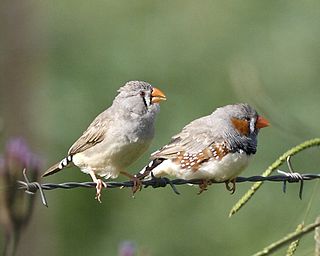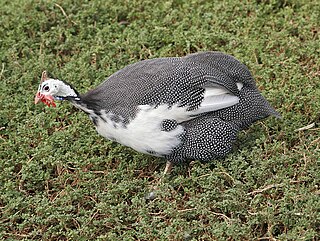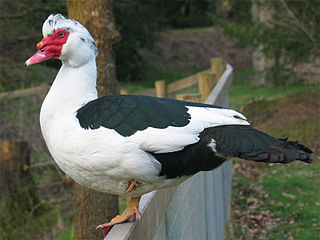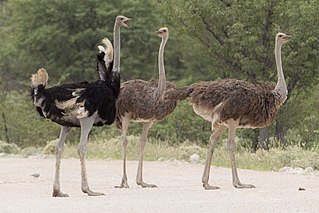 W
WThe domestic canary, often simply known as the canary, is a domesticated form of the wild canary, a small songbird in the finch family originating from the Macaronesian Islands.
 W
WThe chestnut-eared finch or Australian zebra finch is a small Australian bird in the finch family.
 W
WThe cockatiel, also known as weiro bird, or quarrion, is a small parrot that is a member of its own branch of the cockatoo family endemic to Australia. They are prized as household pets and companion parrots throughout the world and are relatively easy to breed. As a caged bird, cockatiels are second in popularity only to the budgerigar.
 W
WDomestic ducks are ducks that are raised for meat, eggs and down. Many ducks are also kept for show, as pets, or for their ornamental value. Almost all varieties of domestic duck apart from the Muscovy duck are descended from the mallard.
 W
WHumans have kept domesticated varieties of geese as poultry for their meat, eggs and down feathers since ancient times. Domestic geese have been derived through selective breeding from the wild greylag goose and swan goose. Approximately 700 million geese are slaughtered each year for meat worldwide as of 2019.
 W
WDomestic guineafowl, sometimes called pintade, pearl hen, or gleany, is poultry originating from Africa. They are the domesticated form of the helmeted guineafowl and are related to other game birds such as the pheasants, turkeys and partridges. Although the timing of their domestication is unknown, there is evidence that domestic guineafowl were present in Greece by the 5th century BC.
 W
WThe Muscovy or Barbary is the domesticated form of the wild Muscovy duck. There are a number of local or regional breeds, and drakes of these are commonly cross-bred with domestic ducks to produce the hybrids called mulards.
 W
WThe domestic pigeon is a pigeon subspecies that was derived from the rock dove. The rock pigeon is the world's oldest domesticated bird. Mesopotamian cuneiform tablets mention the domestication of pigeons more than 5,000 years ago, as do Egyptian hieroglyphics. Research suggests that domestication of pigeons occurred as early as 10,000 years ago.
 W
WThe Barbary dove, ringed turtle dove, ringneck dove, ring-necked turtle dove, or ring dove is a domestic member of the dove family (Columbidae).
 W
WThe rock dove, rock pigeon, or common pigeon is a member of the bird family Columbidae. In common usage, this bird is often simply referred to as the "pigeon".
 W
WThe Muscovy duck is a large duck native to the Americas. Small wild and feral breeding populations have established themselves in the United States, particularly in Florida, Louisiana, Massachusetts, the Big Island of Hawaii, as well as in many other parts of North America, including southern Canada. Feral Muscovy ducks are found in New Zealand, Australia, and in parts of Europe.
 W
WThe emu is the second-largest living bird by height, after its ratite relative, the ostrich. It is endemic to Australia where it is the largest native bird and the only extant member of the genus Dromaius. The emu's range covers most of mainland Australia, but the Tasmanian, Kangaroo Island and King Island subspecies became extinct after the European settlement of Australia in 1788.
 W
WFeral chickens are derived from domestic chickens who have returned to the wild. Like the red junglefowl, feral chickens will roost in bushes in order to avoid predators at night.
 W
WFeral pigeons, also called city doves, city pigeons, or street pigeons, are pigeons that are descended from the domestic pigeons that have returned to the wild. The domestic pigeon was originally bred from the wild rock dove, which naturally inhabits sea-cliffs and mountains. Rock, domestic, and feral pigeons are all the same species and will readily interbreed. Feral pigeons find the ledges of buildings to be a substitute for sea cliffs, have become adapted to urban life, and are abundant in towns and cities throughout much of the world.
 W
WThe Gouldian finch, also known as the Lady Gouldian finch, Gould's finch or the rainbow finch, is a colourful passerine bird that is native to Australia.
 W
WThe star finch is a seed-eating bird species found in northern Australia. It has a distinctive red face and bill, and broad white spots down its flanks. One of its three subspecies may be extinct.
 W
WThe zebra finch is the most common estrildid finch of Central Australia and ranges over most of the continent, avoiding only the cool moist south and some areas of the tropical far north. It can also be found natively on Timor island. The bird has been introduced to Puerto Rico and Portugal.
 W
WThe Lutino cockatiel is one of the most popular mutations of cockatiel, with white to light-yellow feathers and orange cheek patches.
 W
WOld World quail is a collective name for several genera of mid-sized birds in the pheasant family Phasianidae.
 W
WThe common ostrich or simply ostrich, is a species of large flightless bird native to certain large areas of Africa. It is one of two extant species of ostriches, the only living members of the genus Struthio in the ratite order of birds. The other is the Somali ostrich, which was recognized as a distinct species by BirdLife International in 2014 having been previously considered a very distinctive subspecies of ostrich.
 W
WThe Pied cockatiel is the first mutation of cockatiel colour genetics, with a mostly grey to light-yellow and white feathers and orange cheek patches.
 W
WPoultry are domesticated birds kept by humans for their eggs, their meat or their feathers. These birds are most typically members of the superorder Galloanserae (fowl), especially the order Galliformes. The term also includes birds that are killed for their meat, such as the young of pigeons but does not include similar wild birds hunted for sport or food and known as game. The word "poultry" comes from the French/Norman word poule, itself derived from the Latin word pullus, which means small animal.
 W
WThe Japanese quail, Coturnix japonica, also known as the coturnix quail is a species of Old World quail found in East Asia. First considered a subspecies of the common quail, it is now considered as a separate species. The Japanese quail has played an active role in the lives of humanity since the 12th century, and continues to play major roles in industry and scientific research. Where it is found, the species is abundant across most of its range. Currently, there are a few true breeding mutations of the Japanese quail. The breeds from the United States are: Texas A&M, English white, golden range, red range, Italian, Manchurian, Tibetan, rosetta, scarlett, roux dilute and golden tuxedo.
 W
WThe greater rhea is a species of flightless bird native to eastern South America. Other names for the greater rhea include the grey, common, or American rhea; ñandú ; or ema (Portuguese). One of two species in the genus Rhea, in the family Rheidae, the greater rhea is native to Argentina, Bolivia, Brazil, Paraguay and Uruguay. It inhabits a variety of open areas, such as grasslands, savanna or grassy wetlands. Weighing 20–27 kilograms (44–60 lb), the greater rhea is the largest bird in South America. In the wild, the greater rhea has a life expectancy of 10.5 years. It is also notable for its reproductive habits, and for the fact that a population has established itself in Northern Germany in recent years. The species is listed as Near Threatened by the IUCN.
 W
WThe domestic turkey is a large fowl, one of the two species in the genus Meleagris and the same species as the wild turkey. Although turkey domestication was thought to have occurred in central Mesoamerica at least 2,000 years ago, recent research suggests a possible second domestication event in the southwestern United States between 200 BC and AD 500. However, all of the main domestic turkey varieties today descend from the turkey raised in central Mexico that was subsequently imported into Europe by the Spanish in the 16th century.